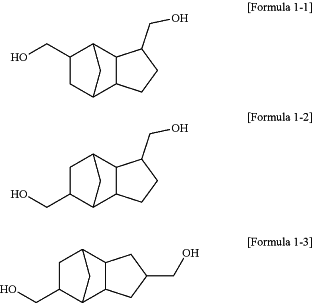| CPC C07C 31/278 (2013.01) [B01J 31/2213 (2013.01); C07C 29/141 (2013.01); C07C 45/50 (2013.01); C08G 63/199 (2013.01); B01J 21/18 (2013.01); B01J 23/462 (2013.01); B01J 2531/82 (2013.01); C07C 2603/68 (2017.05)] | 7 Claims |
|
1. A method of preparing a tricyclodecane dimethanol composition, the method comprising the steps of:
performing a two-step hydroformylation reaction by:
a) adding dropwise dicyclopentadiene at a temperature of 75° C. to 85° C. while maintaining a mixed gas of hydrogen and carbon monoxide at a pressure 20 bar to 150 bar in the presence of a catalyst composition including a rhodium-containing catalyst compound and 5 moles to 200 moles of an organophosphorus compound per 1 mole of rhodium, and a dienophile to form a reaction mixture; and
b) after the dropwise addition of dicyclopentadiene is finished, further reacting the reaction mixture while heating the reaction mixture to 130° C. and maintaining the pressure of the CO/H2 mixed gas;
wherein the method further comprises the steps of:
performing a hydrogenation reaction of tricyclodecane dialdehyde obtained by the two-step hydroformylation reaction in the presence of a hydrogenation catalyst,
wherein the tricyclodecane dimethanol composition includes 20 parts by weight to 35 parts by weight of a first structural isomer represented by the following Formula 1-1, 27 parts by weight to 42 parts by weight of a second structural isomer represented by the following Formula 1-2, and 27 parts by weight to 42 parts by weight of a third structural isomer represented by the following Formula 1-3, based on 100 parts by weight of the composition:
 |